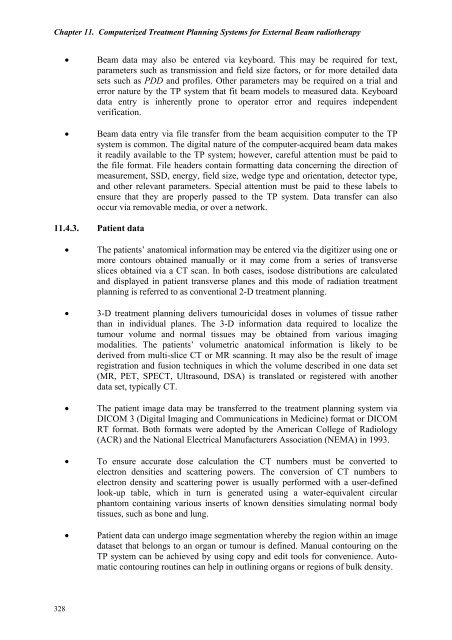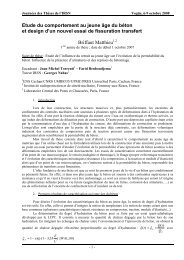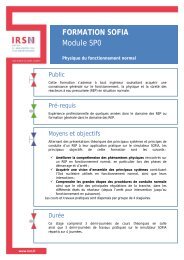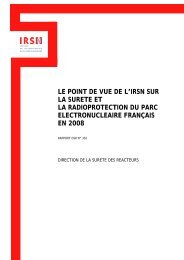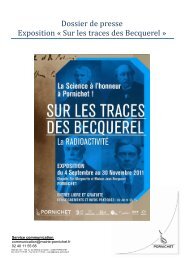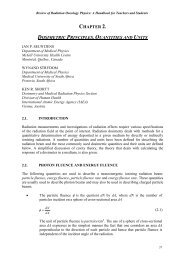Review of Radiation Therapy Physics: A syllabus for teachers ... - IRSN
Review of Radiation Therapy Physics: A syllabus for teachers ... - IRSN
Review of Radiation Therapy Physics: A syllabus for teachers ... - IRSN
Create successful ePaper yourself
Turn your PDF publications into a flip-book with our unique Google optimized e-Paper software.
Chapter 11. Computerized Treatment Planning Systems <strong>for</strong> External Beam radiotherapy• Beam data may also be entered via keyboard. This may be required <strong>for</strong> text,parameters such as transmission and field size factors, or <strong>for</strong> more detailed datasets such as PDD and pr<strong>of</strong>iles. Other parameters may be required on a trial anderror nature by the TP system that fit beam models to measured data. Keyboarddata entry is inherently prone to operator error and requires independentverification.• Beam data entry via file transfer from the beam acquisition computer to the TPsystem is common. The digital nature <strong>of</strong> the computer-acquired beam data makesit readily available to the TP system; however, careful attention must be paid tothe file <strong>for</strong>mat. File headers contain <strong>for</strong>matting data concerning the direction <strong>of</strong>measurement, SSD, energy, field size, wedge type and orientation, detector type,and other relevant parameters. Special attention must be paid to these labels toensure that they are properly passed to the TP system. Data transfer can alsooccur via removable media, or over a network.11.4.3. Patient data• The patients’ anatomical in<strong>for</strong>mation may be entered via the digitizer using one ormore contours obtained manually or it may come from a series <strong>of</strong> transverseslices obtained via a CT scan. In both cases, isodose distributions are calculatedand displayed in patient transverse planes and this mode <strong>of</strong> radiation treatmentplanning is referred to as conventional 2-D treatment planning.• 3-D treatment planning delivers tumouricidal doses in volumes <strong>of</strong> tissue ratherthan in individual planes. The 3-D in<strong>for</strong>mation data required to localize thetumour volume and normal tissues may be obtained from various imagingmodalities. The patients’ volumetric anatomical in<strong>for</strong>mation is likely to bederived from multi-slice CT or MR scanning. It may also be the result <strong>of</strong> imageregistration and fusion techniques in which the volume described in one data set(MR, PET, SPECT, Ultrasound, DSA) is translated or registered with anotherdata set, typically CT.• The patient image data may be transferred to the treatment planning system viaDICOM 3 (Digital Imaging and Communications in Medicine) <strong>for</strong>mat or DICOMRT <strong>for</strong>mat. Both <strong>for</strong>mats were adopted by the American College <strong>of</strong> Radiology(ACR) and the National Electrical Manufacturers Association (NEMA) in 1993.• To ensure accurate dose calculation the CT numbers must be converted toelectron densities and scattering powers. The conversion <strong>of</strong> CT numbers toelectron density and scattering power is usually per<strong>for</strong>med with a user-definedlook-up table, which in turn is generated using a water-equivalent circularphantom containing various inserts <strong>of</strong> known densities simulating normal bodytissues, such as bone and lung.• Patient data can undergo image segmentation whereby the region within an imagedataset that belongs to an organ or tumour is defined. Manual contouring on theTP system can be achieved by using copy and edit tools <strong>for</strong> convenience. Automaticcontouring routines can help in outlining organs or regions <strong>of</strong> bulk density.328


